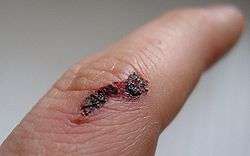Exudate
An exudate is a fluid emitted by an organism through pores or a wound, a process known as exuding or exudation.[1] Exudate is derived from exude, "to ooze,"[2] from the Latin exsūdāre, "to (ooze out) sweat" (ex- "out" and sūdāre "to sweat").[3]

Medicine
An exudate is any fluid that filters from the circulatory system into lesions or areas of inflammation. It can be a pus-like or clear fluid. When an injury occurs, leaving skin exposed, it leaks out of the blood vessels and into nearby tissues. The fluid is composed of serum, fibrin, and white blood cells. Exudate may ooze from cuts or from areas of infection or inflammation.[4]
Types
| Transudate vs. exudate | ||
|---|---|---|
| Transudate | Exudate | |
| Main causes | ↑ hydrostatic pressure, ↓ colloid osmotic pressure |
Inflammation-Increased vascular permeability |
| Appearance | Clear[5] | Cloudy[5] |
| Specific gravity | < 1.012 | > 1.020 |
| Protein content | < 2.5 g/dL | > 2.9 g/dL[6] |
| fluid protein/ serum protein | < 0.5 | > 0.5[7] |
| SAAG = Serum [albumin] - Effusion [albumin] | > 1.2 g/dL | < 1.2 g/dL[8] |
| fluid LDH upper limit for serum | < 0.6 or < 2⁄3 | > 0.6[6] or > 2⁄3[7] |
| Cholesterol content | < 45 mg/dL | > 45 |
| Radiodensity on CT scan | 2 to 15 HU[9] | 4 to 33 HU[9] |
- Purulent or suppurative exudate consists of plasma with both active and dead neutrophils, fibrinogen, and necrotic parenchymal cells. This kind of exudate is consistent with more severe infections, and is commonly referred to as pus.
- Fibrinous exudate is composed mainly of fibrinogen and fibrin. It is characteristic of rheumatic carditis, but is seen in all severe injuries such as strep throat and bacterial pneumonia. Fibrinous inflammation is often difficult to resolve due to blood vessels growing into the exudate and filling space that was occupied by fibrin. Often, large amounts of antibiotics are necessary for resolution.
- Catarrhal exudate is seen in the nose and throat and is characterized by a high content of mucus.
- Serous exudate (sometimes classified as serous transudate) is usually seen in mild inflammation, with relatively low protein.[10] Its consistency resembles that of serum, and can usually be seen in certain disease states like tuberculosis. (See below for difference between transudate and exudate)
- Malignant (or cancerous) pleural effusion is effusion where cancer cells are present.[11] It is usually classified as exudate.
Exudates vs. transudates
There is an important distinction between transudates and exudates. Transudates are caused by disturbances of hydrostatic or colloid osmotic pressure, not by inflammation. They have a low protein content in comparison to exudates. Medical distinction between transudates and exudates is through the measurement of the specific gravity of extracted fluid. Specific gravity is used to measure the protein content of the fluid. The higher the specific gravity, the greater the likelihood of capillary permeability changes in relation to body cavities. For example, the specific gravity of the transudate is usually less than 1.012 and a protein content of less than 2 g/100 mL (2 g%). Rivalta test may be used to differentiate an exudate from a transudate. It is not clear if there is a distinction in the difference of transudates and exudates in plants.
Plant exudates
Plant exudates include saps, gums, latex, and resin. Sometimes nectar is considered an exudate.[12] Plant roots and seeds exudate a variety of molecules into the rhizosphere, including acids, sugars, polysaccharides and ectoenzymes; this can account for 40% of root carbon.[13] Exudation of these compounds has various benefits to the plant and to the microorganisms of the rhizosphere.[14][15]
See also
References
- "exudate". The Free Dictionary - Medical. Retrieved 5 August 2014.
- ""Exude" Merriam-Webster Online Dictionary". Merriam Webster. 2008. Retrieved 2008-07-04.
- Robert K. Barnhart, ed. (1988). Chambers Dictionary of Etymology. New York: Chambers Harrap Publishers. p. 363. ISBN 0-550-14230-4.
- "Exudate". MedlinePlus.
- The University of Utah • Spencer S. Eccles Health Sciences Library > WebPath images > "Inflammation".
- Heffner J, Brown L, Barbieri C (1997). "Diagnostic value of tests that discriminate between exudative and transudative pleural effusions. Primary Study Investigators". Chest. 111 (4): 970–80. doi:10.1378/chest.111.4.970. PMID 9106577.
- Light R, Macgregor M, Luchsinger P, Ball W (1972). "Pleural effusions: the diagnostic separation of transudates and exudates". Ann Intern Med. 77 (4): 507–13. doi:10.7326/0003-4819-77-4-507. PMID 4642731.
- Roth BJ, O'Meara TF, Gragun WH (1990). "The serum-effusion albumin gradient in the evaluation of pleural effusions". Chest. 98 (3): 546–9. doi:10.1378/chest.98.3.546. PMID 2152757.
- Cullu, Nesat; Kalemci, Serdar; Karakas, Omer; Eser, Irfan; Yalcin, Funda; Boyaci, Fatma Nurefsan; Karakas, Ekrem (2013). "Efficacy of CT in diagnosis of transudates and exudates in patients with pleural effusion". Diagnostic and Interventional Radiology. doi:10.5152/dir.2013.13066. ISSN 1305-3825.
- Robbins Basic Pathology 7th ed
- About.com > Malignant Pleural Effusion By Lynne Eldridge MD. Updated March 27, 2010
- Power, Michael L. (2010). Anne M. Burrows; Leanne T. Nash (eds.). The Evolution of Exudativory in Primates / Nutritional and Digestive Challenges to Being a Gum-feeding Primate. Springer. p. 28. ISBN 9781441966612. Retrieved 2 October 2012.
- Marschner, Horst (1995). Mineral Nutrition of Higher Plants. ISBN 0124735436.
- Walker, T. S.; Bais, H. P.; Grotewold, E.; Vivanco, J. M. (2003). "Root Exudation and Rhizosphere Biology". Plant Physiology. 132 (1): 44–51. doi:10.1104/pp.102.019661. PMC 1540314. PMID 12746510.
- Martins, S. J.; Medeiros, F. H. V.; Lakshmanan, V.; Bais, H. P. (2018). "Impact of Seed Exudates on Growth and Biofilm Formation of Bacillus amyloliquefaciens ALB629 in Common Bean". Frontiers in Microbiology. 8: 2631. doi:10.3389/fmicb.2017.02631. PMC 5767182. PMID 29375501.
External links
